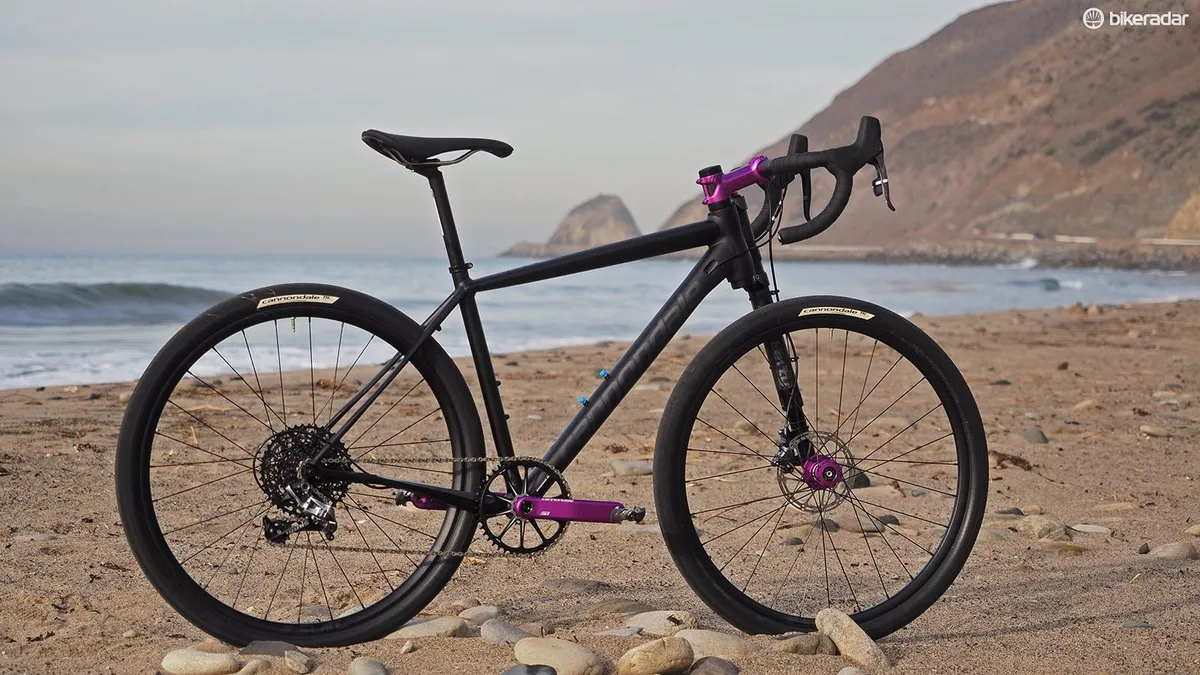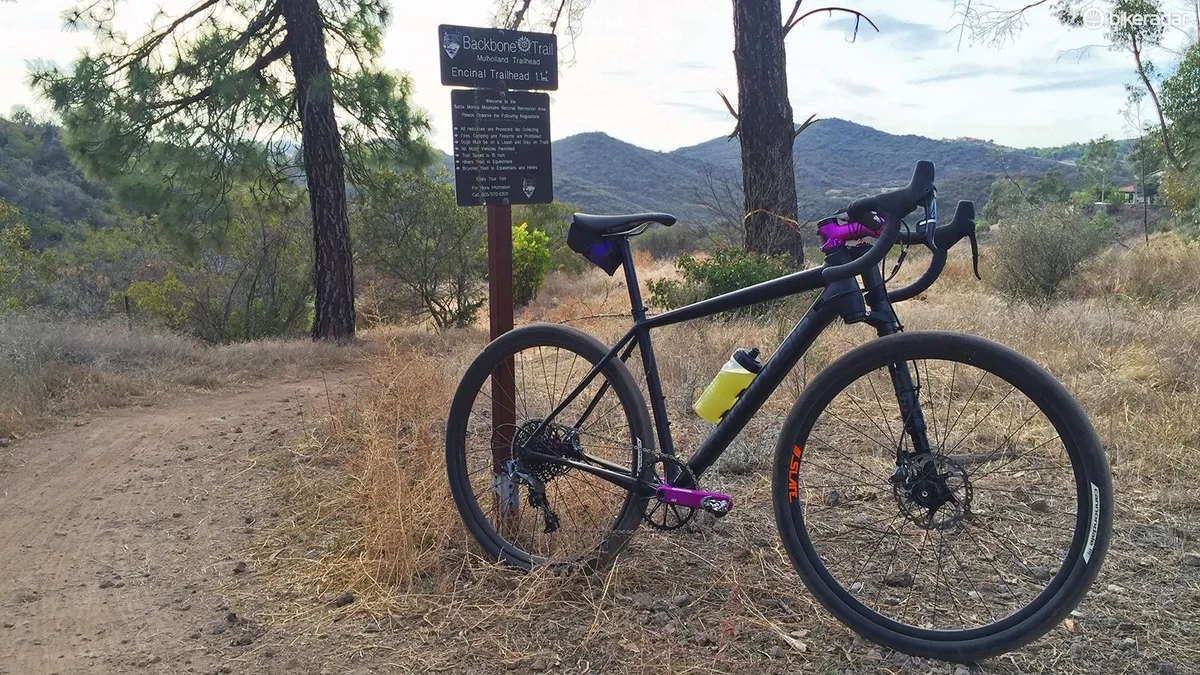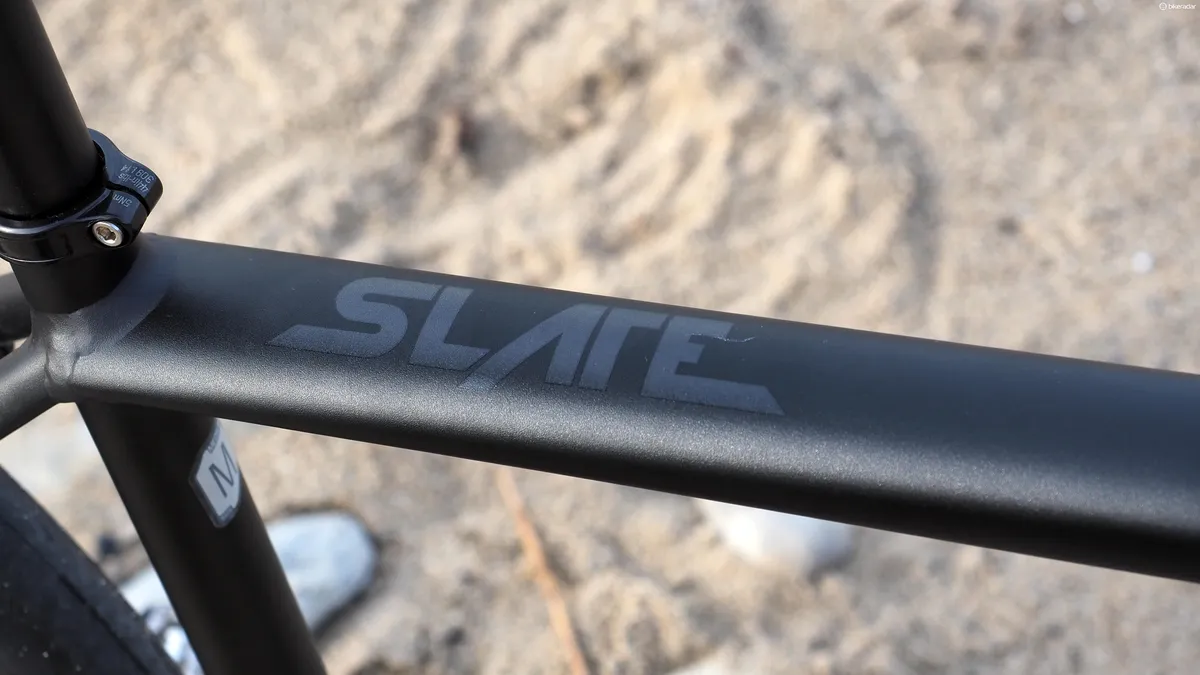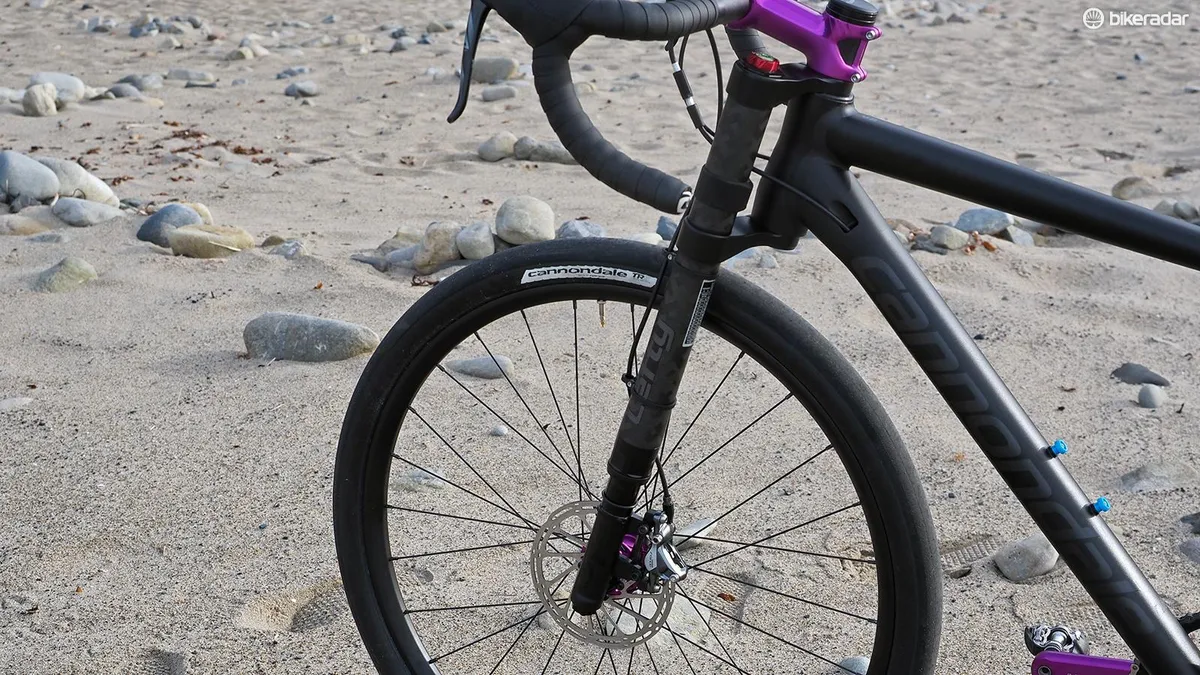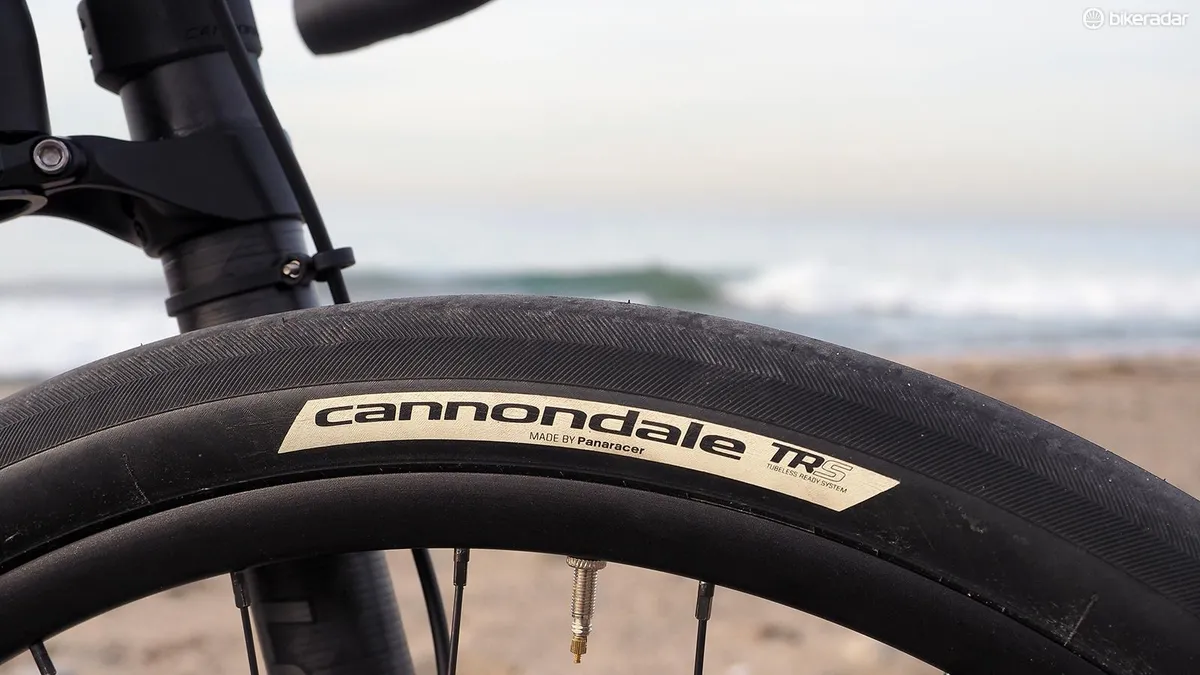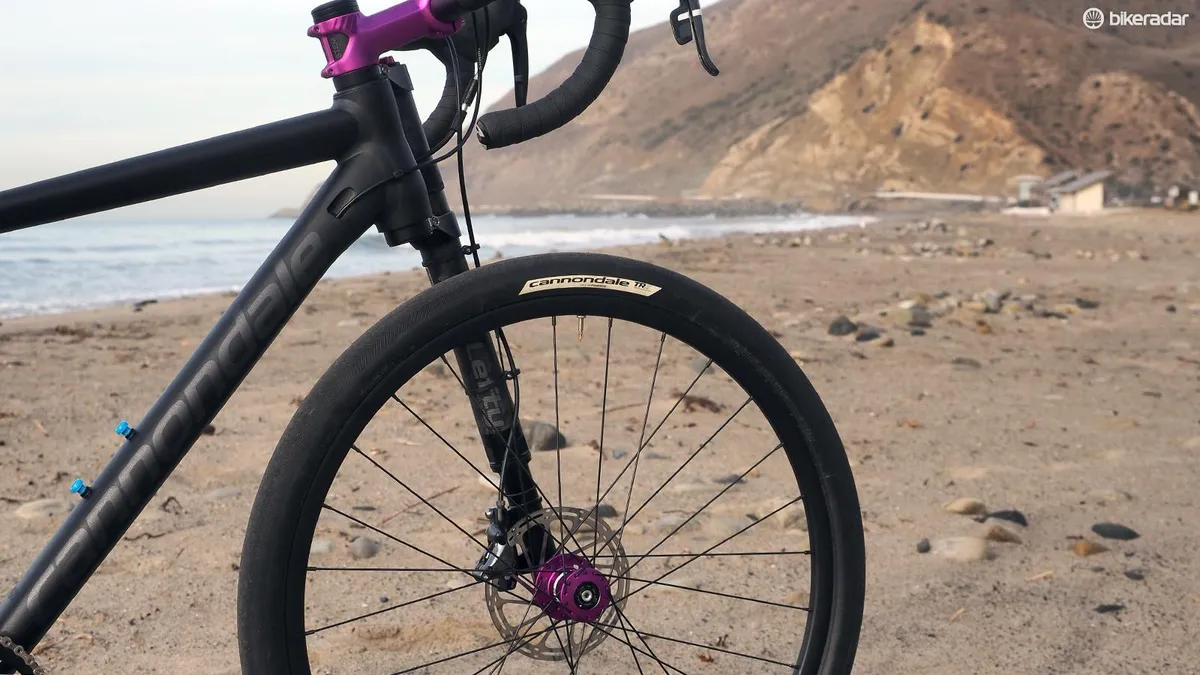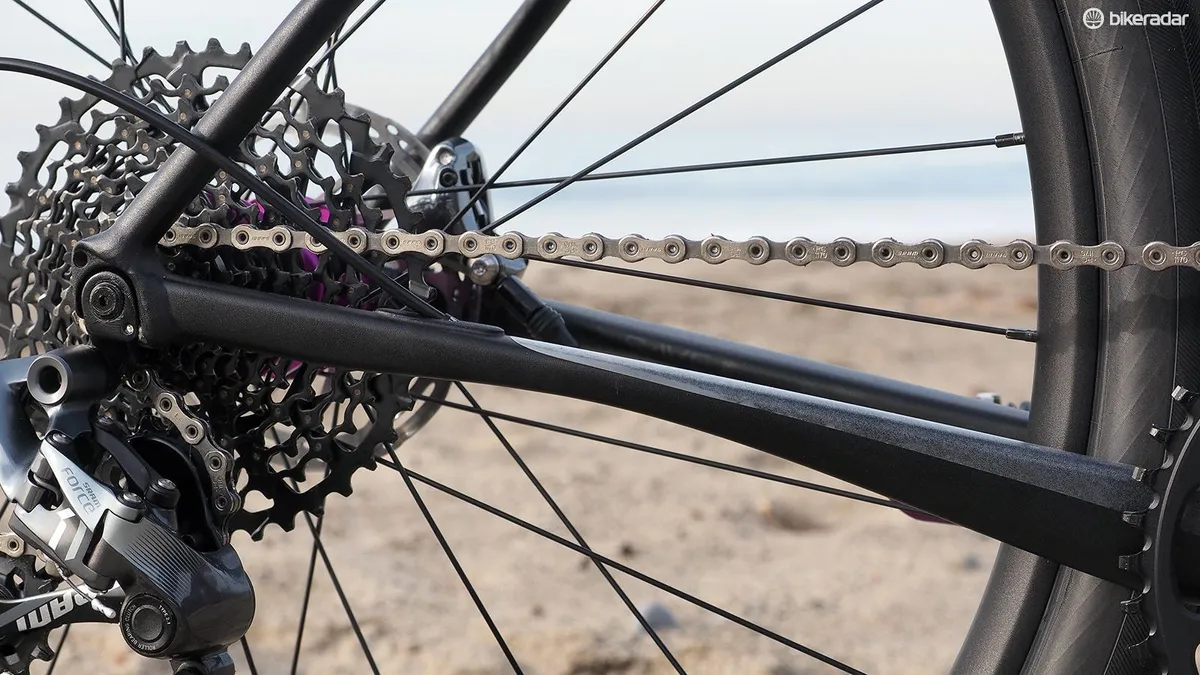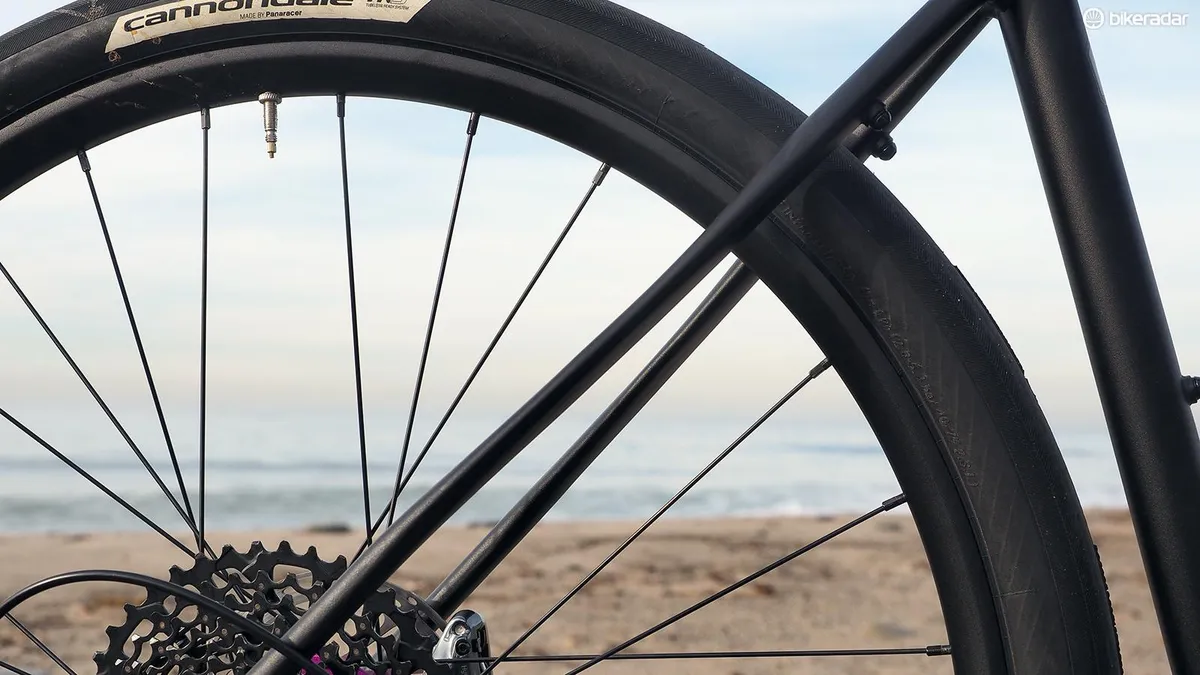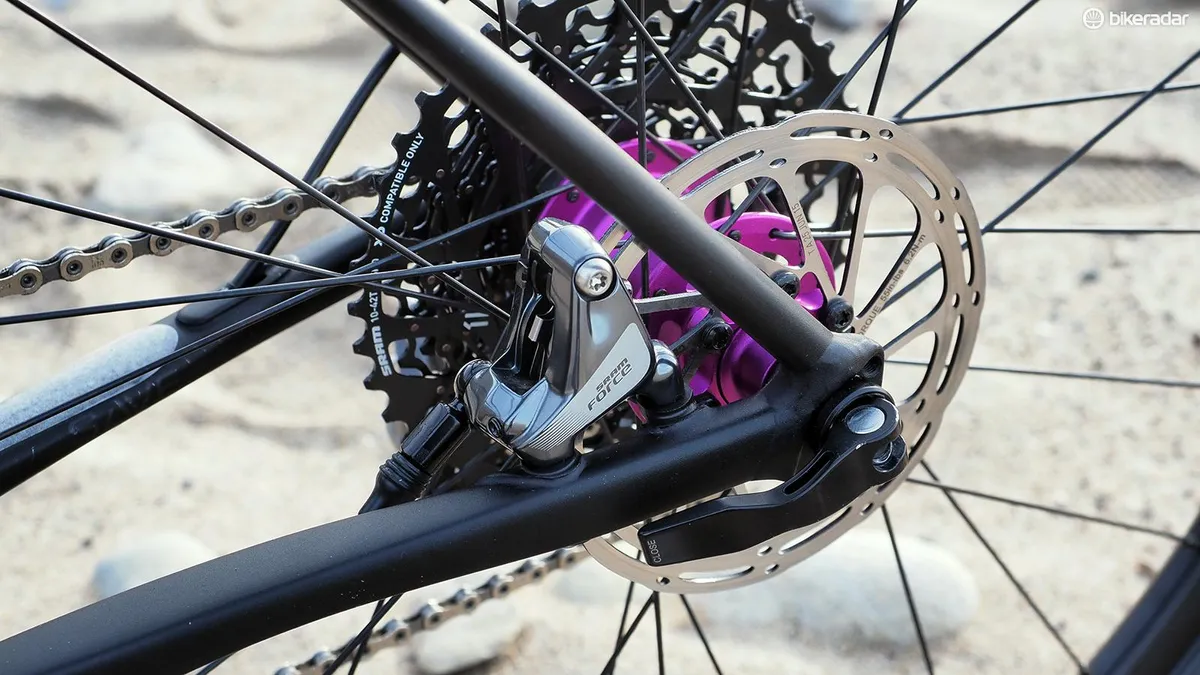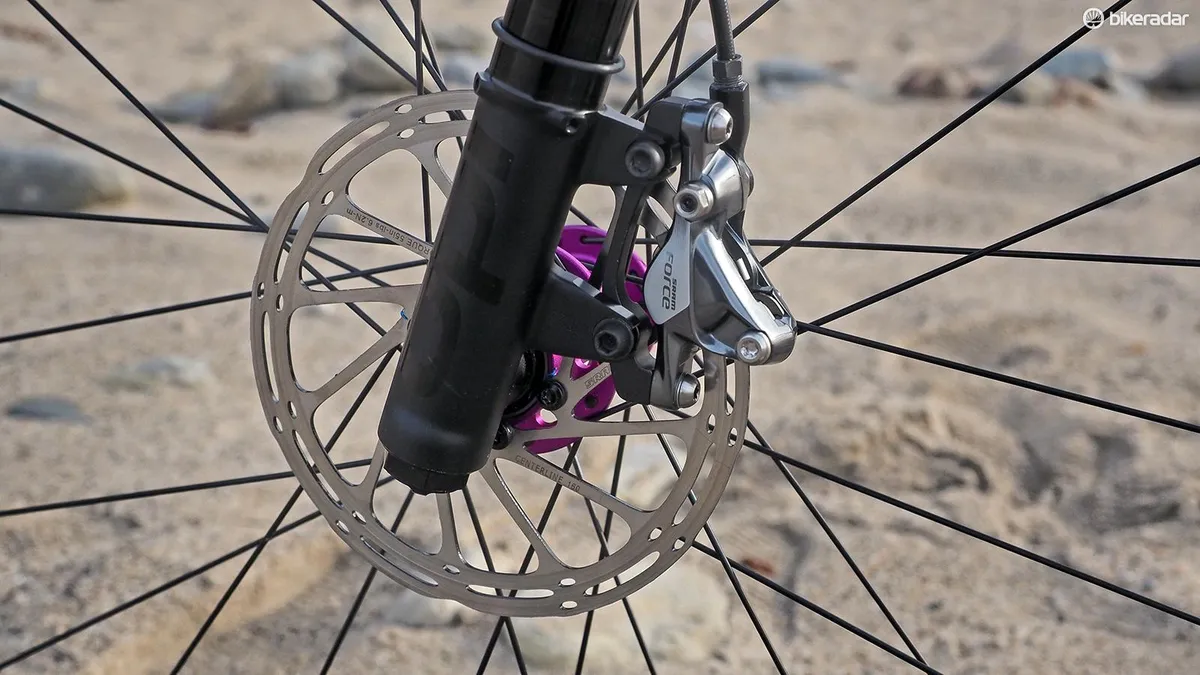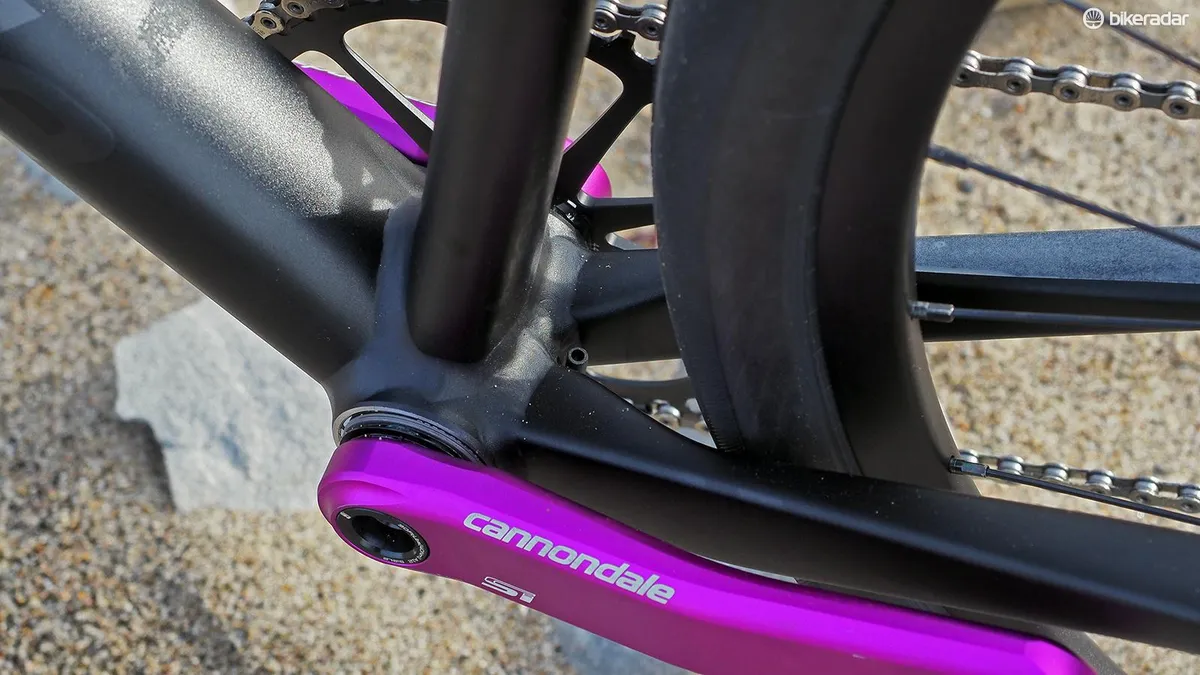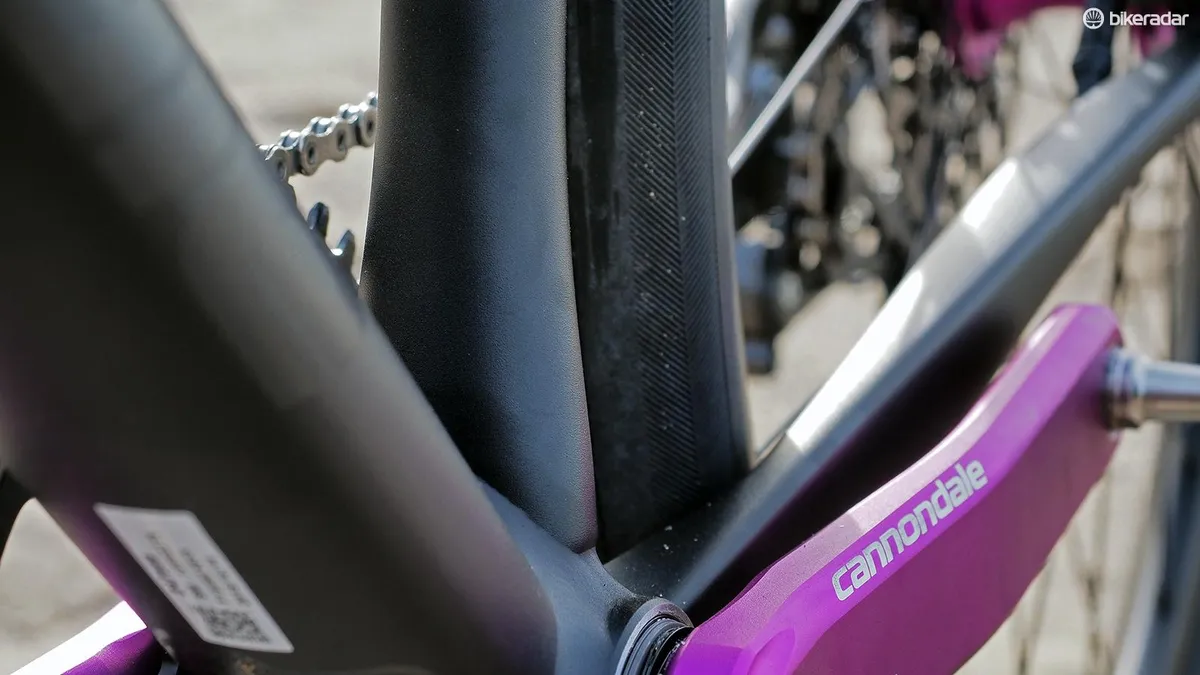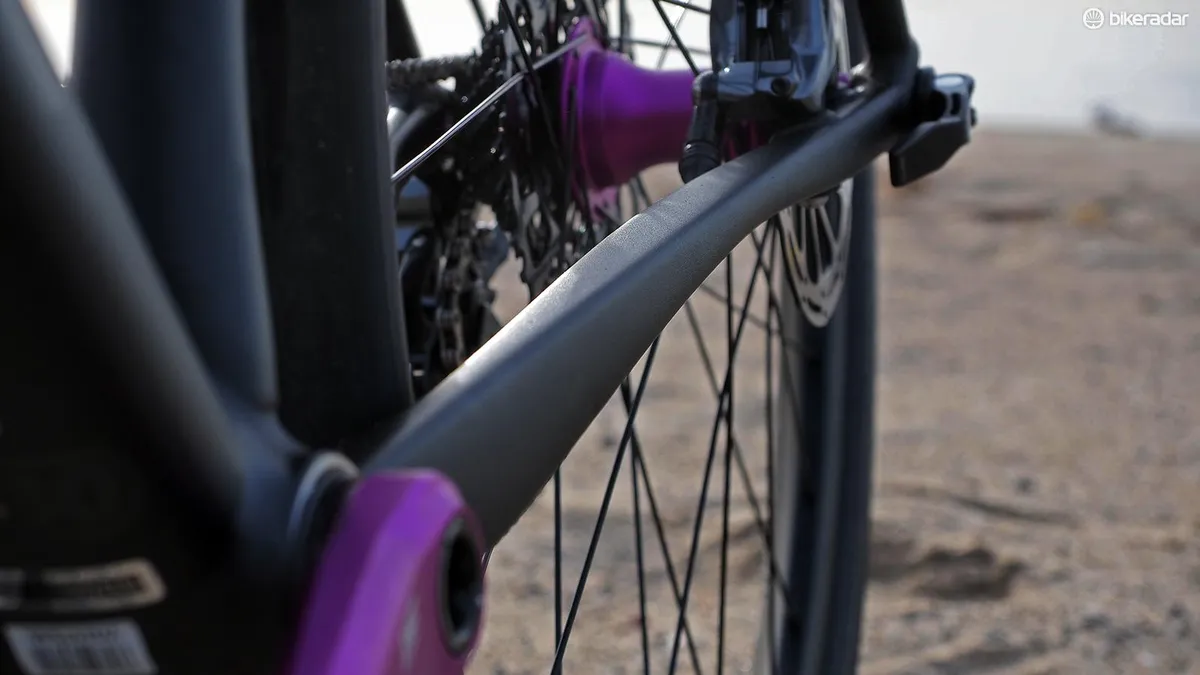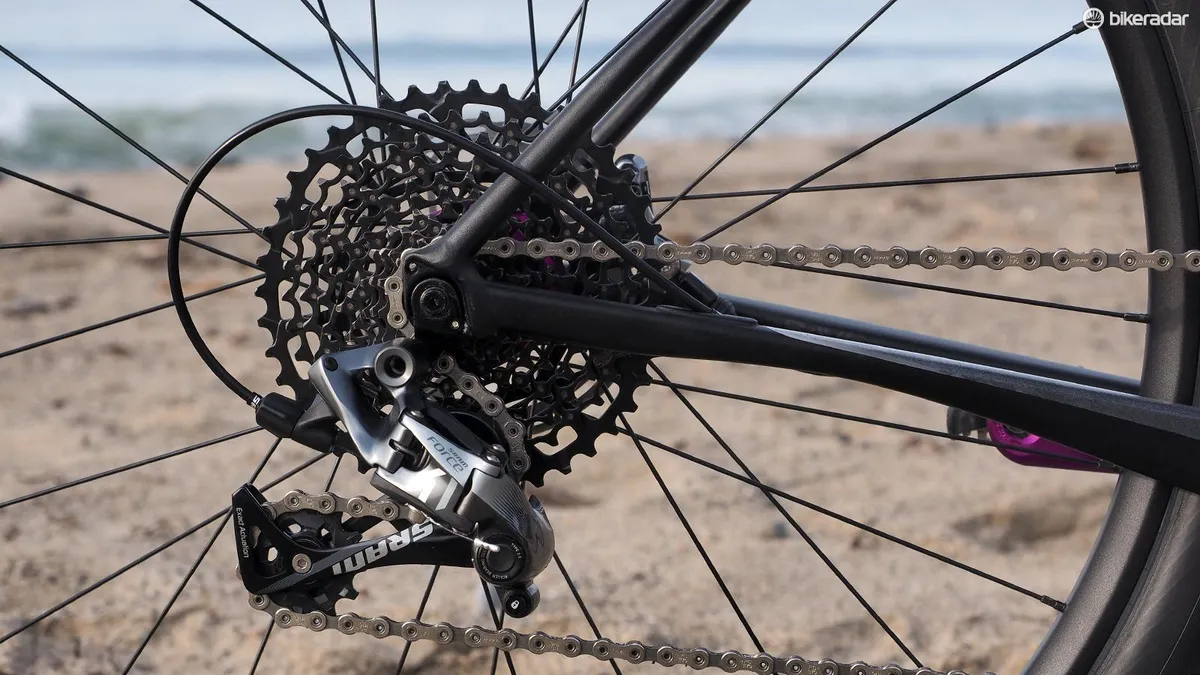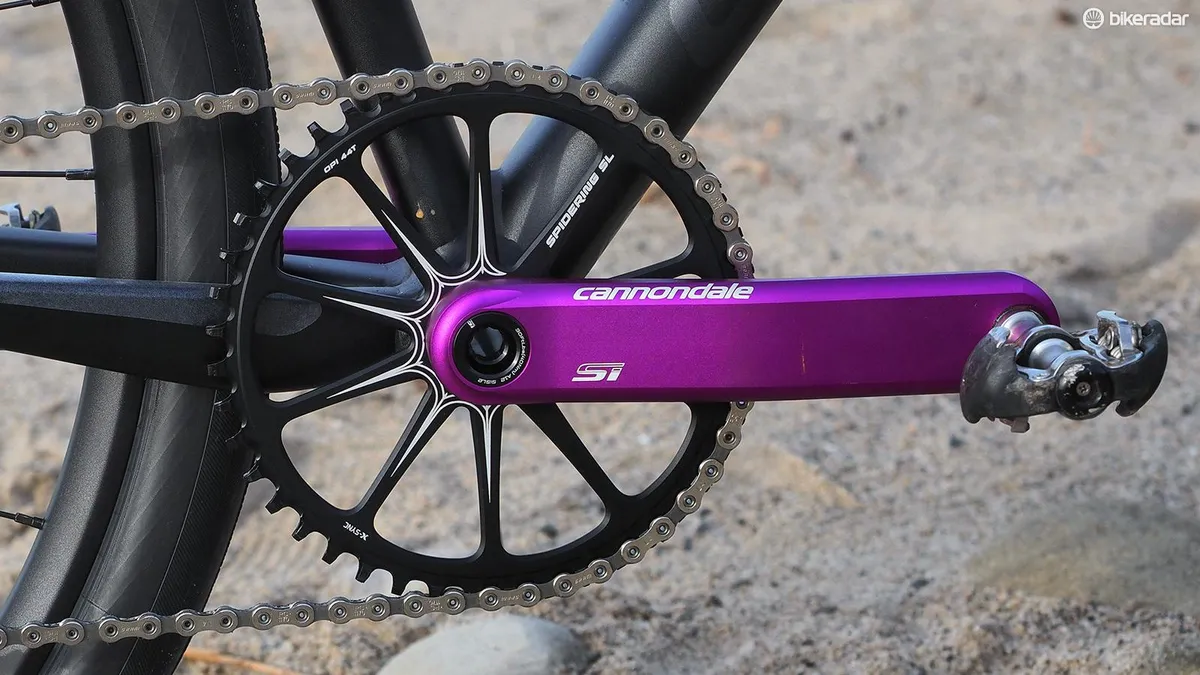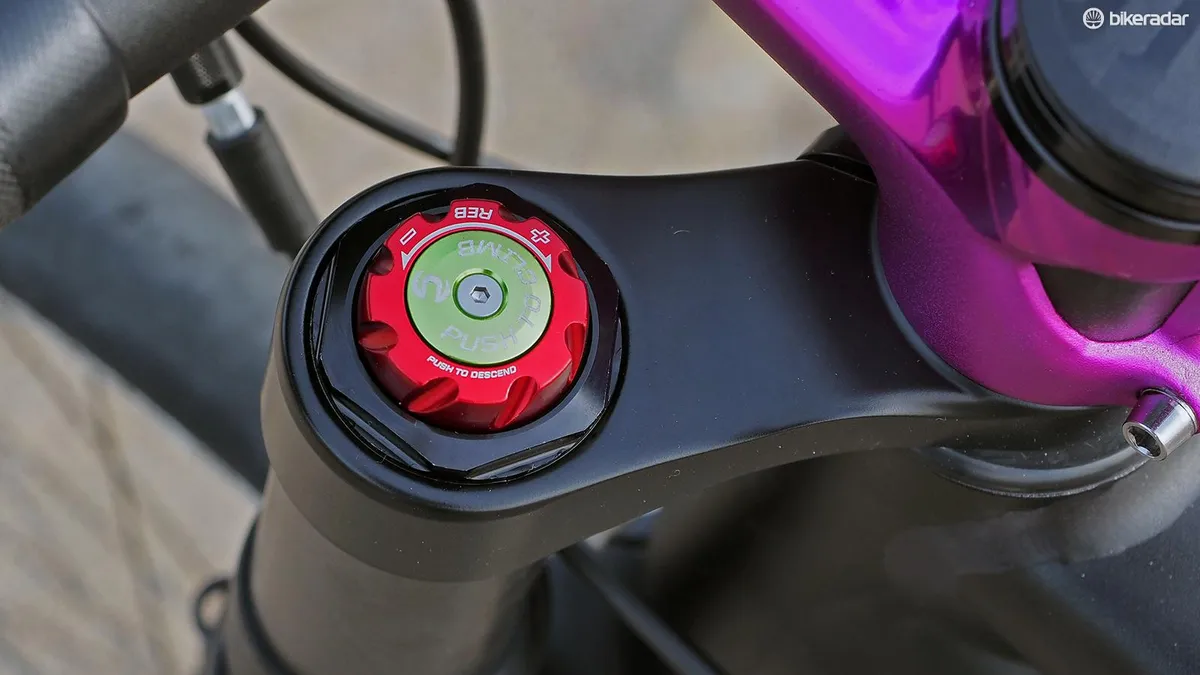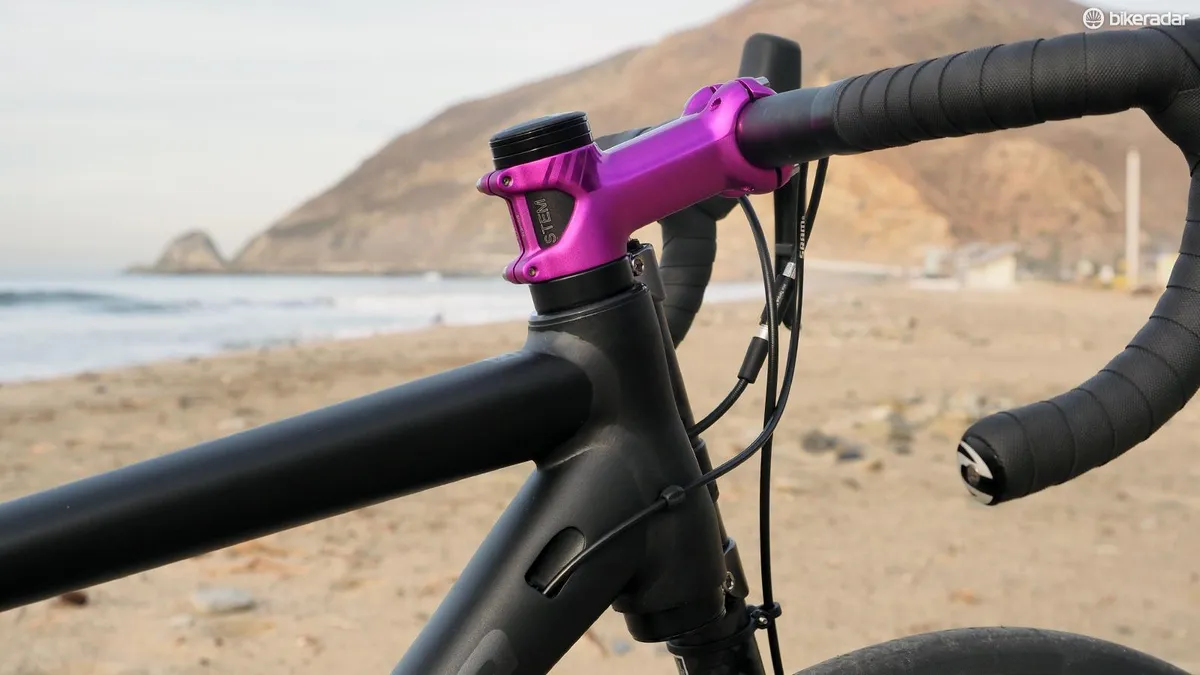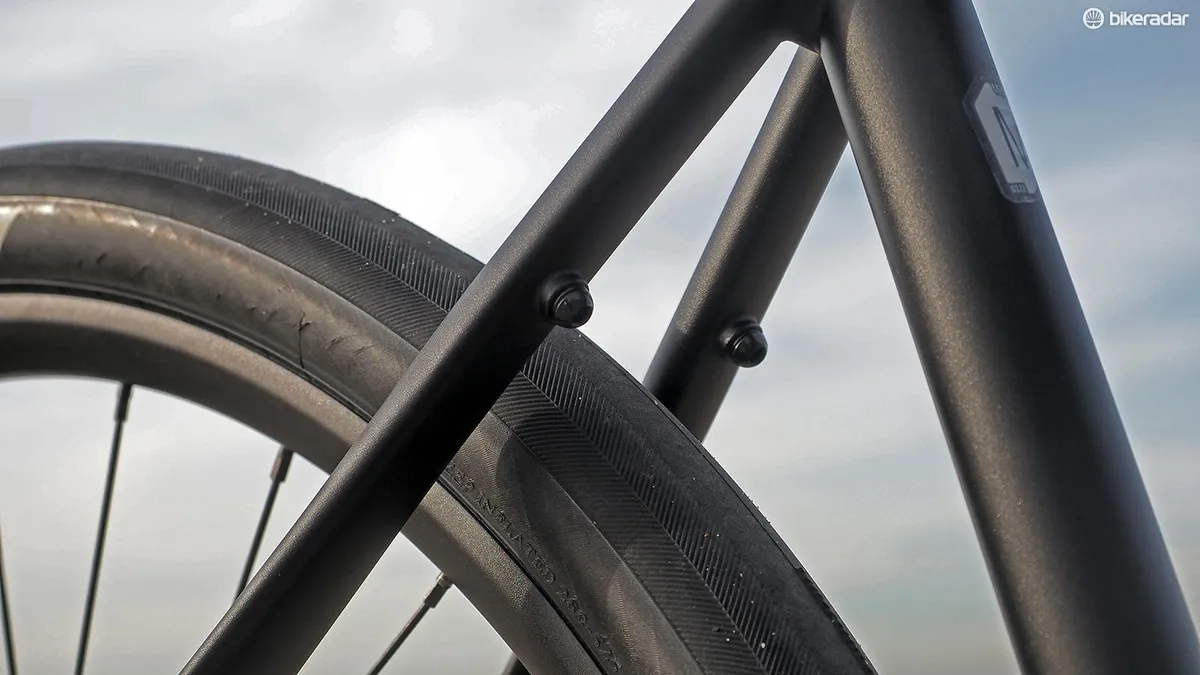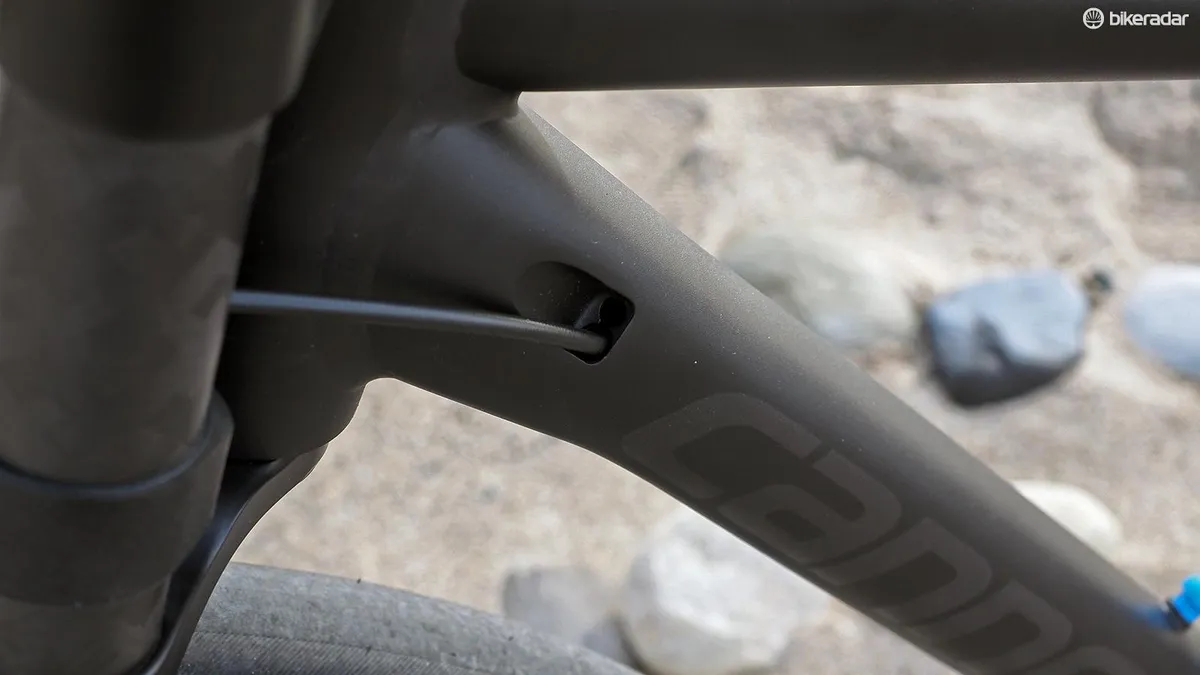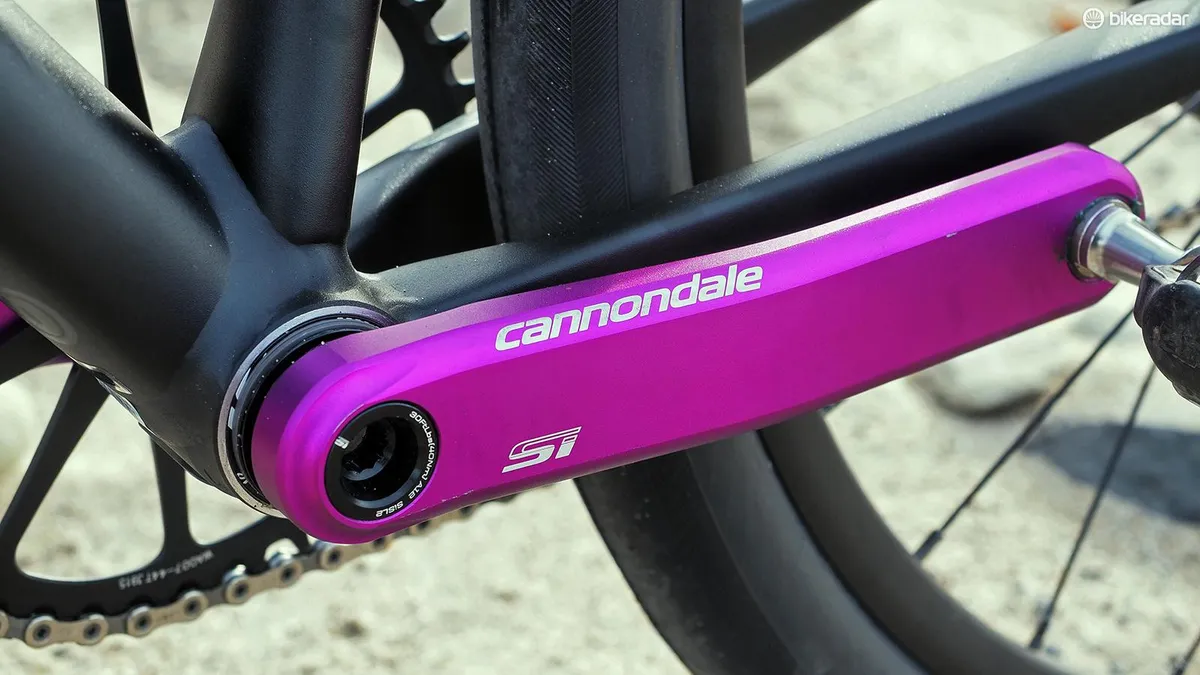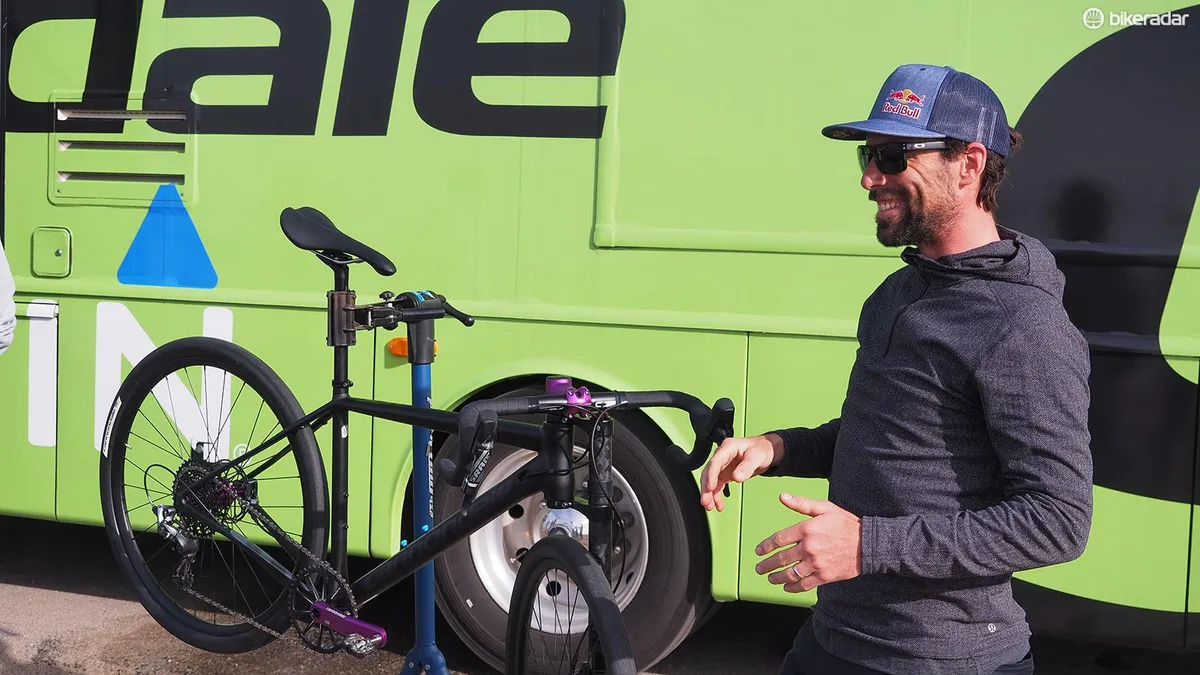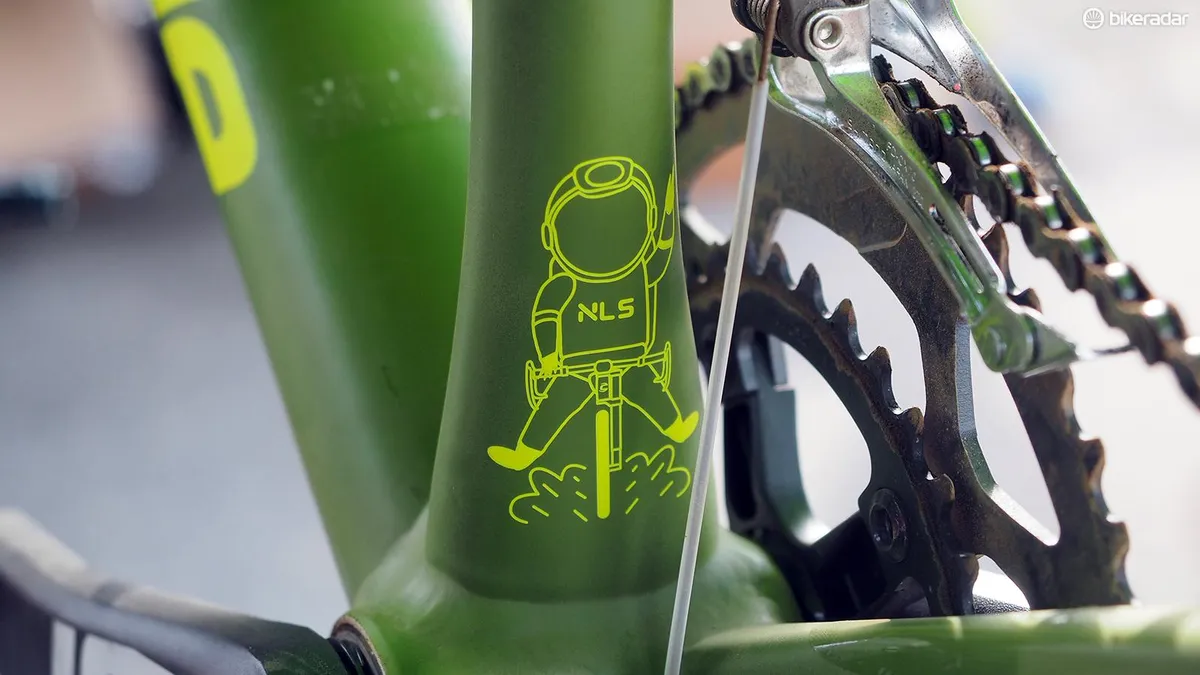Cannondale is no stranger to shaking things up a bit but the new Slate is an especially bold move. It’s a road bike of sorts but with a very broad definition of the word 'road'. Built with 42mm-wide slick tires, a specially made suspension fork with just 30mm of travel, disc brakes, and a surprisingly aggressive geometry that falls somewhere in between your typical race and endurance machines, it's one of 2015's true chimeras.
I recently flew out to Malibu, California to spend a day on the Slate on a mix of pavement (both good and bad), dirt, and demandingly rocky pathways in the sunbaked hills overlooking the Pacific Ocean. While the experience was absolutely fun, the bike left me with plenty of questions that will have to be answered in the coming weeks and months.
What’s a Slate?
The Slate is so unusual that no discussion of its ride performance would be appropriate without a thorough explanation of the bike itself. Cannondale has seriously broken the mold here.
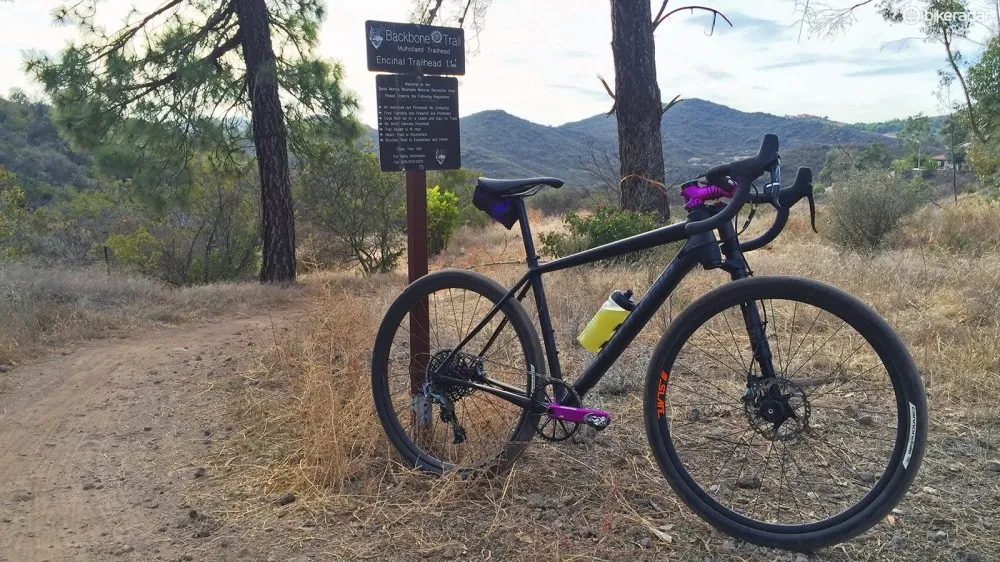
The Slate is the road analogue of a 'plus' mountain bike
Instead of conventional 700c wheels with standard-width tires, the Slate is designed around smaller 650b but ultra-fat 42mm-wide rubber – a combination that Cannondale says yields the same rollout (within a couple of millimeters) as a conventional 700x23mm setup. To further soak up the bumps, the front of the Slate features the radical Lefty Oliver, a road-specific version of Cannondale’s venerable single-sided, dual-crown suspension fork built around a carbon fiber outer chassis and a one-piece forged aluminum lower section.
Given that the Slate is designed to run on a wide range of surfaces, it’s perhaps no surprise that the tube shapes place a big priority on rider comfort (at least out back given that the front end is suspended). Both the chainstays and seatstays are radically flattened through their midsections to supposedly provide more vertical give on bumpy terrain, and the compact front triangle leaves a lot of exposed seatpost to flex under load.
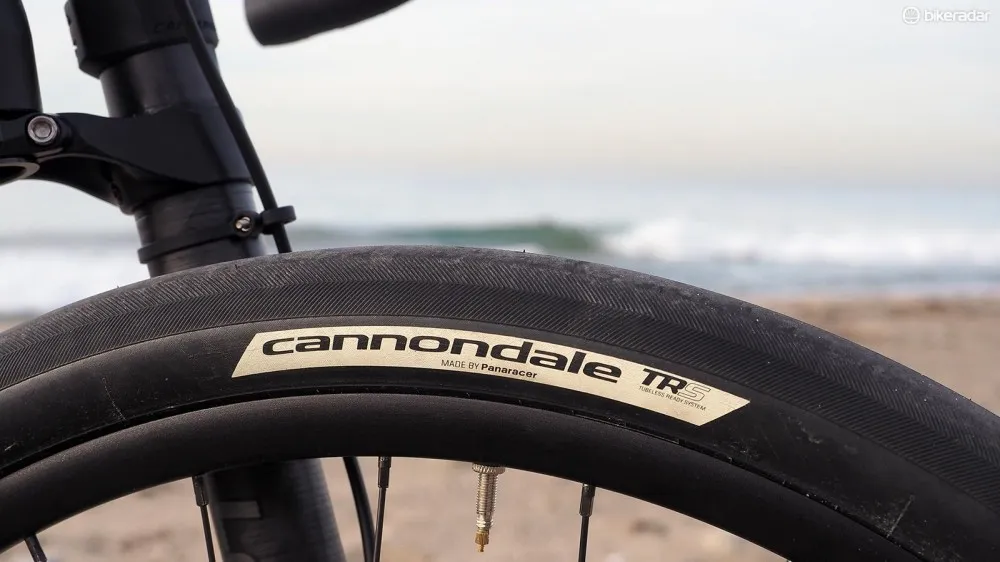
650x42mm tires are relatively common amongst the handbuilt crowd but a definite rarity among mainstream brands
Speaking of which, Cannondale has consciously chosen a 27.2mm diameter here instead of the easier-bending 25.4mm size used on its newest Synapse endurance bike. Why, you ask? So as to make it easier for buyers to add a dropper post if desired. The frame’s cable routing layout even includes an extra port for internally routed ‘stealth’-style models.
Despite the unconventional specs, the Slate’s frame geometry is surprisingly normal, including short 405mm chainstays, a 71-71.5-degree head tube angle, a 73-74.5-degree seat tube angle, a cyclocross-like 65-70mm of bottom bracket drop, and rather aggressive stack heights. (The bike comes in four sizes, thus the range of angles and BB drop.) Fore-aft reach has been pushed out slightly for better stability on loose terrain, however, and stem lengths are slightly shorter to compensate.
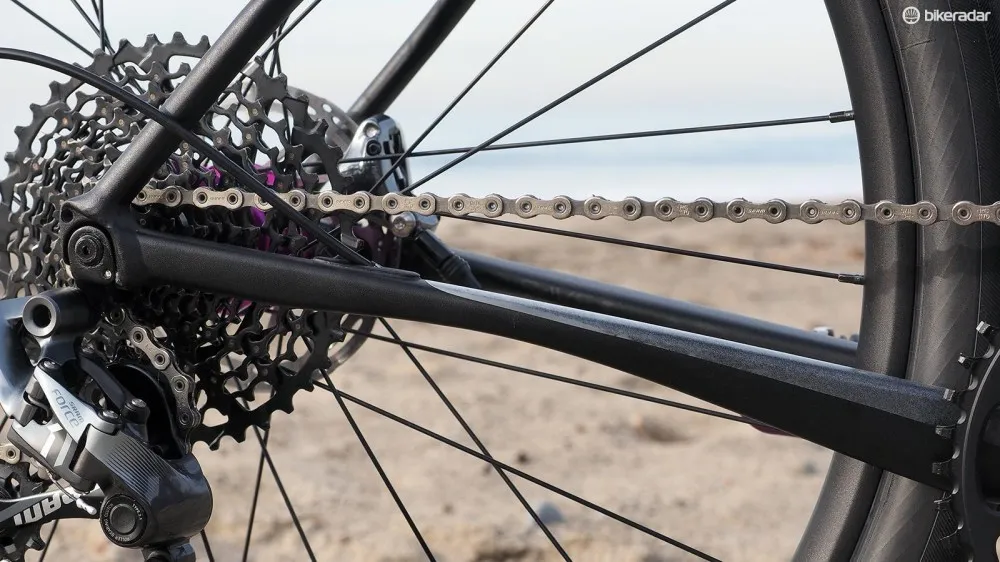
Radically shaped stays promise a super smooth ride out back in combination with the plump tires
Overall, though, the Slate may look a little goofy but the positioning is totally conventional. And although there isn’t a smidgeon of aerodynamic consideration baked in anywhere, that’s just fine given this bike’s more adventurous and freewheeling intents.
For this first taste test, Cannondale provided me with a top-end Slate Force 1 model, built with a SRAM Force 1 transmission, Cannondale’s own Si hollow-forged aluminum cranks and trick narrow/wide direct-mount chainring, SRAM Force hydraulic disc brakes, and custom wheels featuring wide tubeless-ready aluminum rims and matching 42mm-wide tires made by Panaracer.
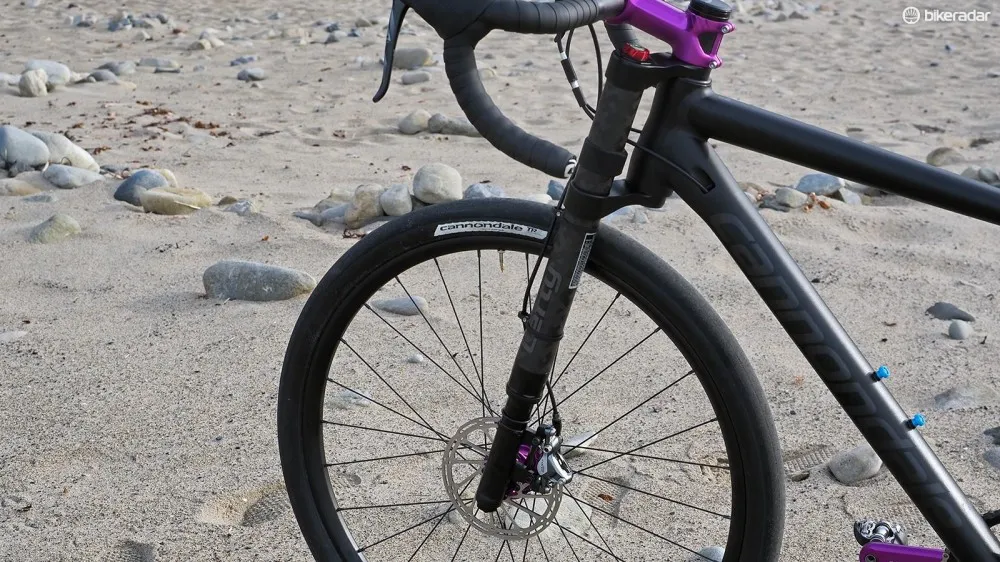
30mm of firm travel is on tap from the Cannondale Lefty Oliver fork
Actual weight for the complete bike was 9.07kg (20.02lb) for a medium size without pedals, set up tubeless. Retail price for this flagship version is $4,250 / £2,999 but Cannondale will also offer two other models for those on tighter budgets, all with the same fork and wheel-and-tire package: one with Shimano Ultegra for $3,520 / £2,799 and an entry-level version with Shimano 105 for $2,980 / £2,499. Prices for other regions are still to be confirmed.
Hitting the hills
Along with a group of Cannondale employees and other journalists, our test ride started out with a gentle 20km (7.5mi) warm-up along the Pacific Coast Highway – a pleasantly rolling ribbon of smooth tarmac buffeted by steady ocean breezes and dotted with fantastic views. Despite having just 42psi in the tires to start, the Slate rolls across the ground much faster than you might expect – much like any other ‘regular’ road bike, in fact. It carries speed nicely, decimates smaller bumps and coarse texture, and feels impressively efficient with little tactile evidence that you’re riding anything other than your everyday road machine. With little difficulty, I was even able to replicate my usual position, too.
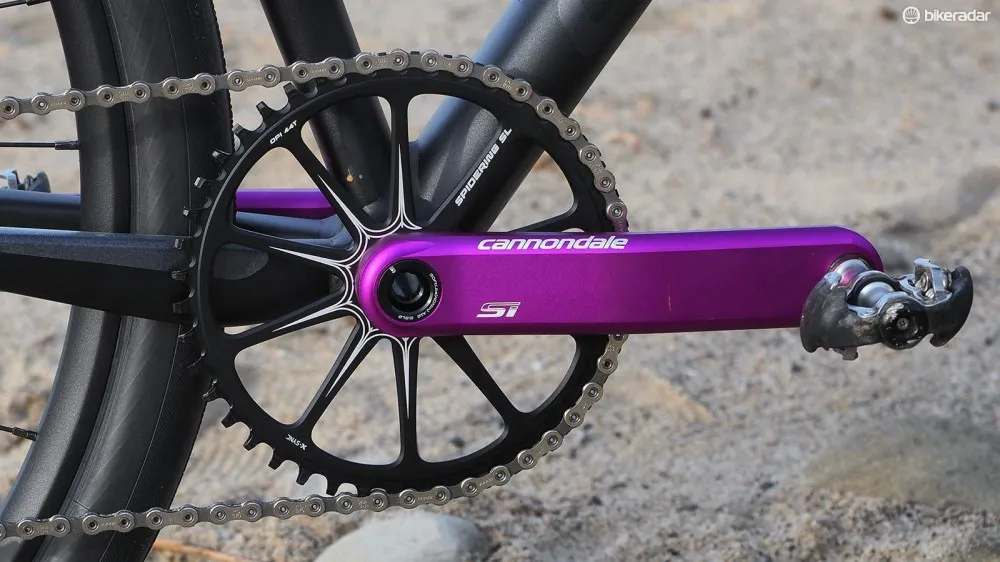
The 1x drivetrain works well for casual cruising but the big ratio jumps aren't always ideal
From there, we headed inland and upward along one of the area’s lightly trafficked canyon roads. Although the bike’s total weight was noticeable, the Slate is quite the capable climber – a testament to the excellent overall chassis rigidity and the spritely rolling performance of the Panaracer tires. Cannondale intentionally built the Lefty Oliver’s damper with lots of low-speed compression damping. Adding in the fact that it’s meant to be run with virtually zero sag, and there’s almost no bobbing up front when climbing out of the saddle.Still, there is some noticeable movement. If that bothers you, a quick tap on the button atop the crown locks the fork in place for an ultra-firm platform. For those of you who have never ridden a Lefty, don’t fret about the single-sided design. It might look a little weird from the saddle but it’s rock-solid with no flex to speak of.
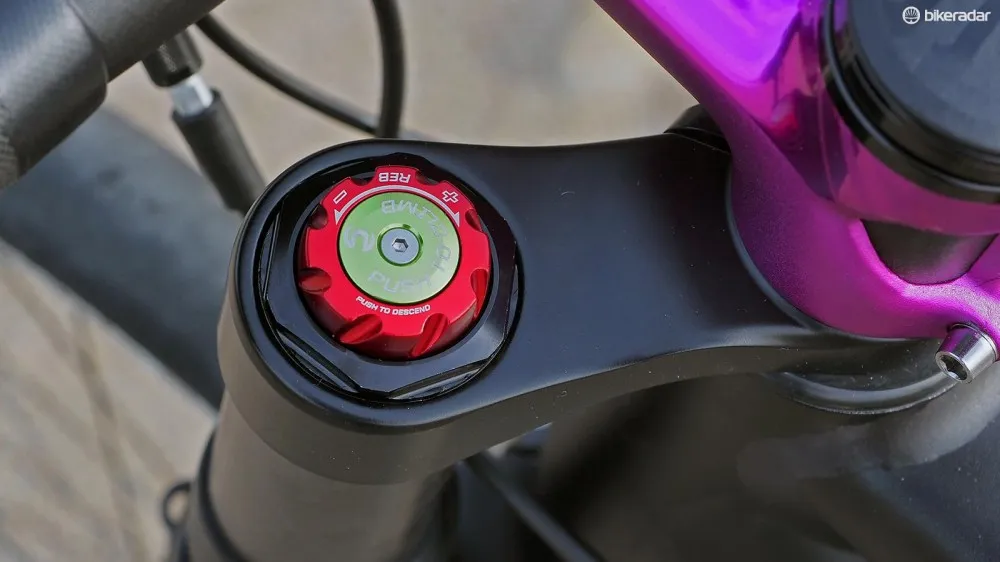
Simply push the center of the knob stack to lock out the fork on climbs
The wide ratio jumps on the SRAM 10-42T cassette occasionally made it a little awkward to maintain my desired cadence, but it’s a reasonable trade-off for the drivetrain’s proven chain retention and incredibly quiet running relative to a standard 2x setup – at least for this style of riding. The clutch derailleur keeps the chain taut and less prone to smacking the chainstay as you ride over rough patches.
Hitting the dirt
It was once we turned off the pavement and on to the Backbone Trail that the real excitement began. Although relatively tame by mountain bike standards, Backbone is unrelenting terrain for a conventional road bike with lots of loose rocks over hardpacked dirt, stretches of soft sand, and lots of off-camber corners that constantly threaten to throw you over the side of the hill. It was here that my opinion of the Slate was most polarized.
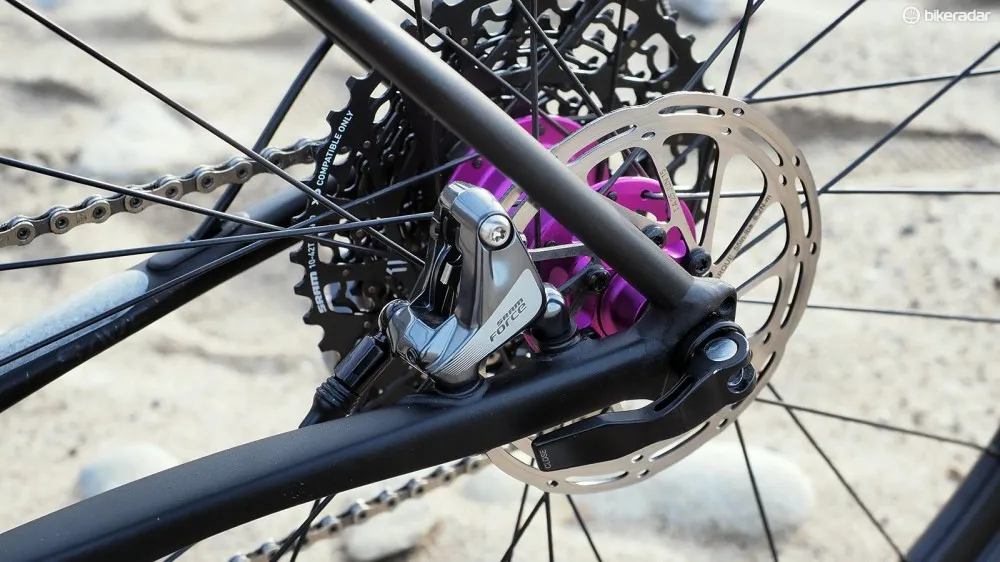
Disc brakes in the dirt? Yum, yum
Despite the generous tire volume, minimal suspension, and heavily shaped rear end, the Slate still rides a little rough on that sort of surface at 42psi so I brought the tires down closer to 35psi. At that point, I could really just let it hang out, bombing straight downhill sections, gleefully jumping over small rocks, and just generally having a good time. Ultimately, there’s just no substitute for a big, fat tire when it comes to cushioning.
That said, Cannondale really missed a big opportunity when it came to the tire tread – or rather, the lack thereof. This criticism might not hold as true on softer dirt but with no shoulder knobs to speak of whatsoever, cornering on the Slate in loose conditions was a full-on white knuckle experience with virtually no warning at all when the tire is about to break loose. In fact, at least three riders in our group crashed on the dirt sections, all due to a lack of cornering traction.
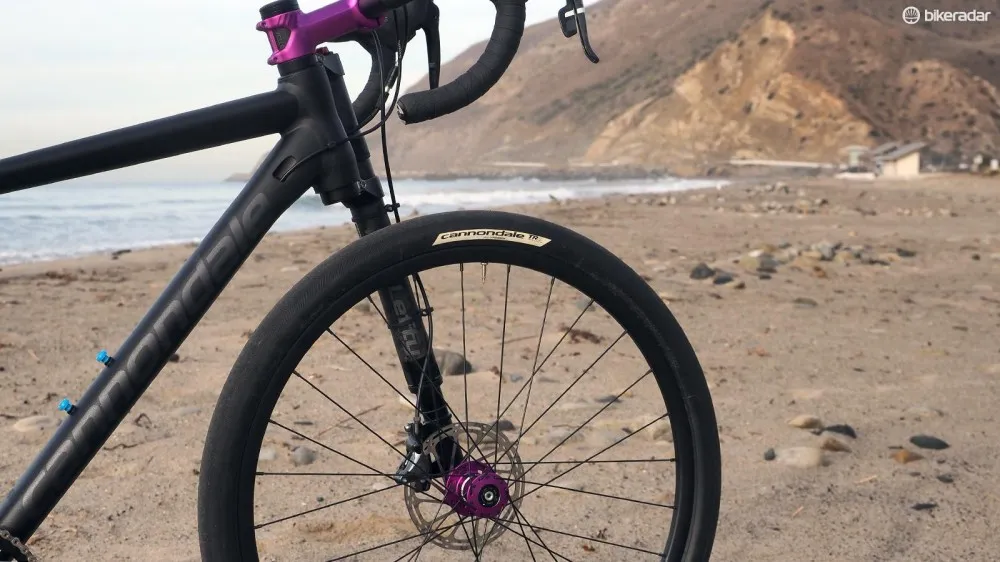
The lack of cornering knobs on the mostly slick tires was a major hindrance when taking the Slate off-road
I also found myself wishing that Cannondale had pushed the envelope even more in terms of the bike’s front center dimension. While it was nice that the front wheel was a little further out front, it didn’t feel like enough of a difference to be worthwhile as I regularly found myself wanting to descend with my hands on the tops for better weight distribution and control (which unfortunately also meant that I sometimes didn’t have quick access to the brakes).
Those tires are also disappointingly fragile with paper-thin casings and sidewalls that are prone to cuts. I counted at least three flats – all due to slashed sidewalls – none of which stood a remote chance of self-repairing with the sealant sloshing around inside. Three cheers for empty energy bar wrappers.
Rocketing back down
We ended the ride with a sweeping descent down Decker Canyon Road – a sinuous and delectably entertaining snake of asphalt that winds its way back down to the coast with countless hairpin corners. Here, the Slate shown in many ways but, again, disappointed in others.
The 42mm-wide tires offer massive cornering grip (I was still running mid-30s pressure) but also incredible composure under hard braking, further aided by the ultra-rigid dual-crown fork and its huge-diameter upper chassis.

Although the tires are very wide, they're no larger in terms of overall diameter than a standard 700x23c setup, so the chainstays are refreshingly short
It took a few corners before I adjusted to the Slate’s enhanced capabilities but once I did, it definitely made for one of the most entertaining downhill runs I’ve had in recent memory.
That said, I wasn’t entirely convinced by the Slate’s handling. Though impressively stable at high speeds, it’s somewhat reluctant to initiate turns and has to be muscled into corners. Moreover, it’s unforgiving if you have poor braking technique, standing up and straightening out hard if you clamp down on the brakes mid-corner.
In addition, that impressively low rolling resistance that I noticed at 42psi completely reversed course when brought down closer to 35psi. Whereas a good cyclocross tires still feels fast on pavement at even lower pressures, the ones on the Slate suddenly felt like they were rolling through molasses – a sensation corroborated by several other journalists at the event.
Cannondale ambassador – and former pro road and ’cross racer – Tim Johnson perhaps summed up the Slate’s personality best.
“It really benefits good fundamentals. But the reverse of that is that is also punishes poor fundamentals.”
More questions than answers
Overall, I got back on the plane at the end of the day with a decidedly mixed opinion on the Slate. On the one hand, Cannondale has apparently done a great job of replicating the feel of a standard road bike but with 42mm-wide tires that definitely offer more capability than any 25mm-wide tire could hope for.
However, so much of that potential is squandered by the fragile tires, which smooth out rough ground but are much too skittish on looser terrain to exploit what should otherwise be a super capable and versatile machine. A little bit of shoulder tread (and some light casing reinforcement) would be most welcome here, even if it comes at the expense of a few grams.
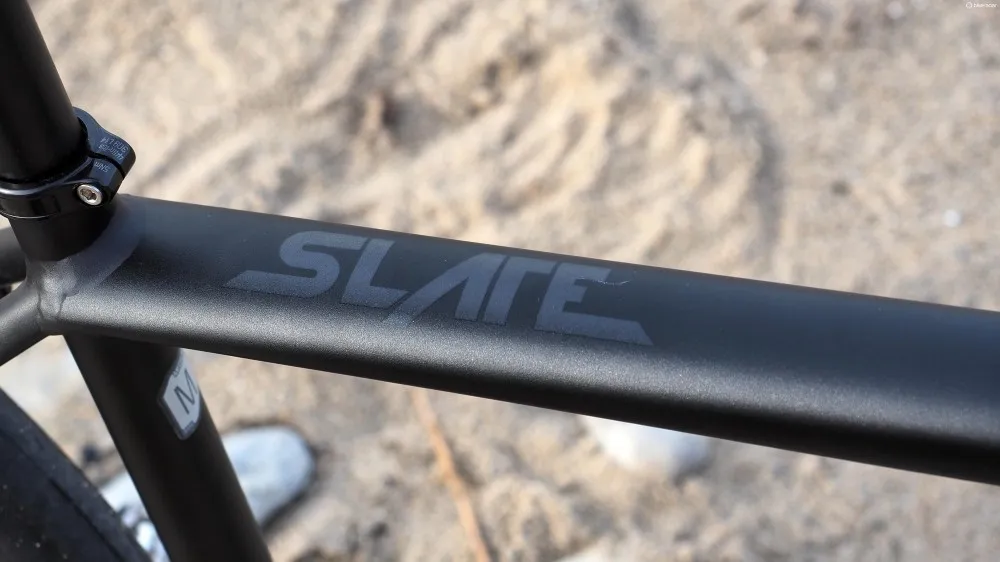
The jury's still out on the Slate
So who’s the Slate for? And why not just get a ’cross bike? Those – among others – are good questions that I am not able to answer with just a single test ride. There are too many variables I still want to play with on more familiar terrain, including tire pressure, fork setup and cockpit positioning.
We’ve got a long-term tester inbound so hopefully those answers will come soon enough.
For more information, visit www.cannondale.com.
